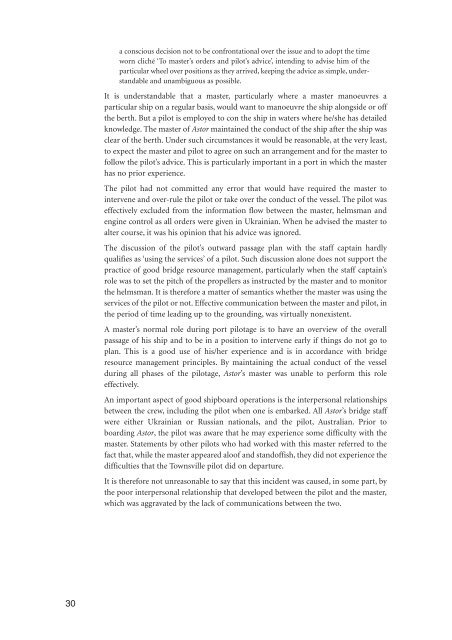MARINE SAFETY INVESTIGATION REPORT No. 200
MARINE SAFETY INVESTIGATION REPORT No. 200
MARINE SAFETY INVESTIGATION REPORT No. 200
You also want an ePaper? Increase the reach of your titles
YUMPU automatically turns print PDFs into web optimized ePapers that Google loves.
30<br />
a conscious decision not to be confrontational over the issue and to adopt the time<br />
worn cliché ‘To master’s orders and pilot’s advice’, intending to advise him of the<br />
particular wheel over positions as they arrived, keeping the advice as simple, understandable<br />
and unambiguous as possible.<br />
It is understandable that a master, particularly where a master manoeuvres a<br />
particular ship on a regular basis, would want to manoeuvre the ship alongside or off<br />
the berth. But a pilot is employed to con the ship in waters where he/she has detailed<br />
knowledge. The master of Astor maintained the conduct of the ship after the ship was<br />
clear of the berth. Under such circumstances it would be reasonable, at the very least,<br />
to expect the master and pilot to agree on such an arrangement and for the master to<br />
follow the pilot’s advice. This is particularly important in a port in which the master<br />
has no prior experience.<br />
The pilot had not committed any error that would have required the master to<br />
intervene and over-rule the pilot or take over the conduct of the vessel. The pilot was<br />
effectively excluded from the information flow between the master, helmsman and<br />
engine control as all orders were given in Ukrainian. When he advised the master to<br />
alter course, it was his opinion that his advice was ignored.<br />
The discussion of the pilot’s outward passage plan with the staff captain hardly<br />
qualifies as ‘using the services’ of a pilot. Such discussion alone does not support the<br />
practice of good bridge resource management, particularly when the staff captain’s<br />
role was to set the pitch of the propellers as instructed by the master and to monitor<br />
the helmsman. It is therefore a matter of semantics whether the master was using the<br />
services of the pilot or not. Effective communication between the master and pilot, in<br />
the period of time leading up to the grounding, was virtually nonexistent.<br />
A master’s normal role during port pilotage is to have an overview of the overall<br />
passage of his ship and to be in a position to intervene early if things do not go to<br />
plan. This is a good use of his/her experience and is in accordance with bridge<br />
resource management principles. By maintaining the actual conduct of the vessel<br />
during all phases of the pilotage, Astor’s master was unable to perform this role<br />
effectively.<br />
An important aspect of good shipboard operations is the interpersonal relationships<br />
between the crew, including the pilot when one is embarked. All Astor’s bridge staff<br />
were either Ukrainian or Russian nationals, and the pilot, Australian. Prior to<br />
boarding Astor, the pilot was aware that he may experience some difficulty with the<br />
master. Statements by other pilots who had worked with this master referred to the<br />
fact that, while the master appeared aloof and standoffish, they did not experience the<br />
difficulties that the Townsville pilot did on departure.<br />
It is therefore not unreasonable to say that this incident was caused, in some part, by<br />
the poor interpersonal relationship that developed between the pilot and the master,<br />
which was aggravated by the lack of communications between the two.
















